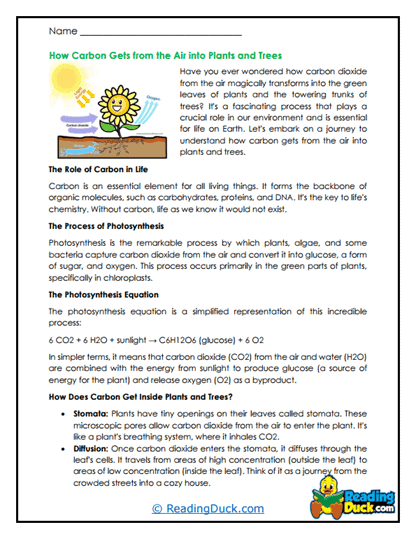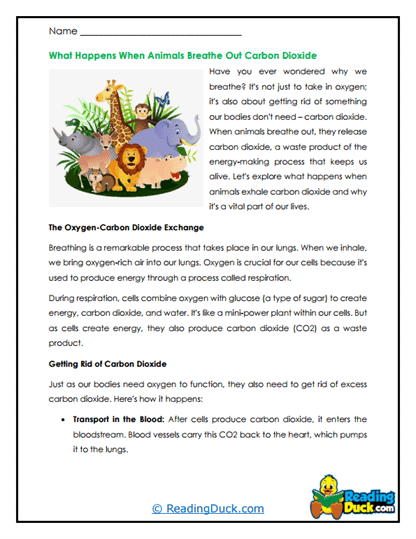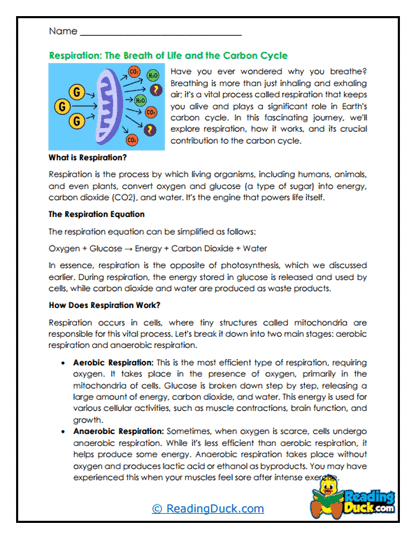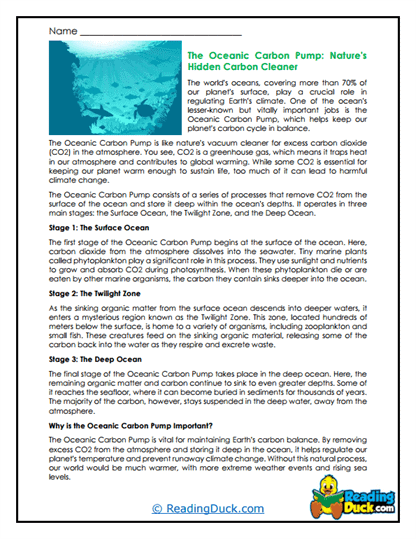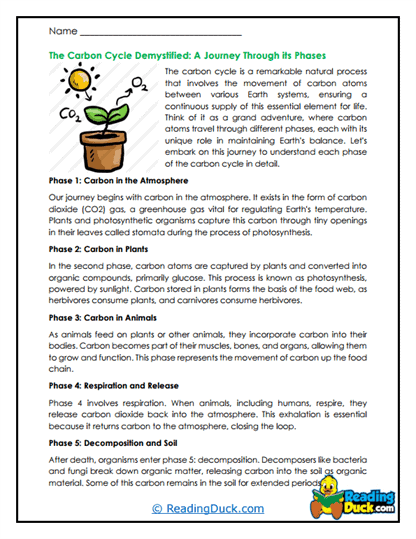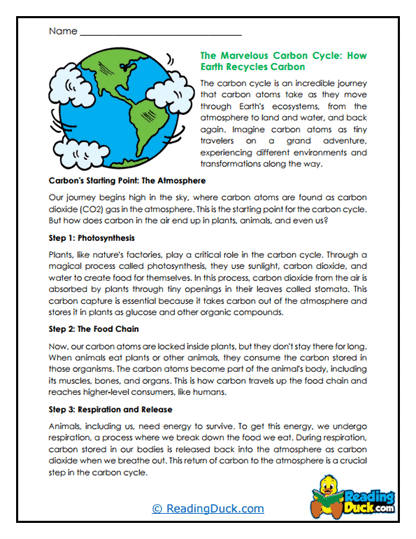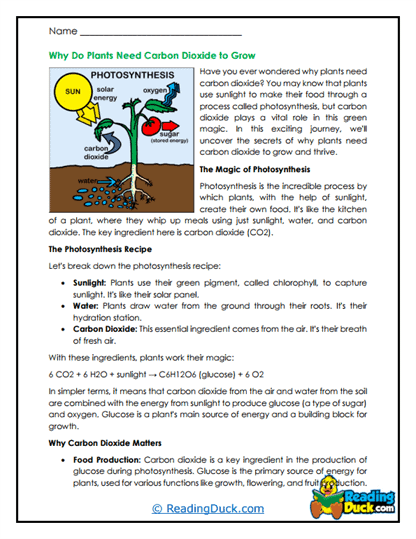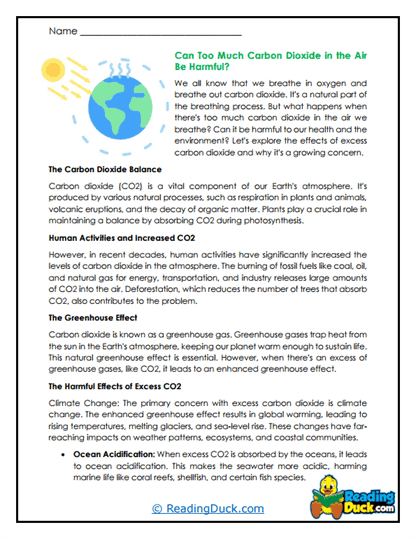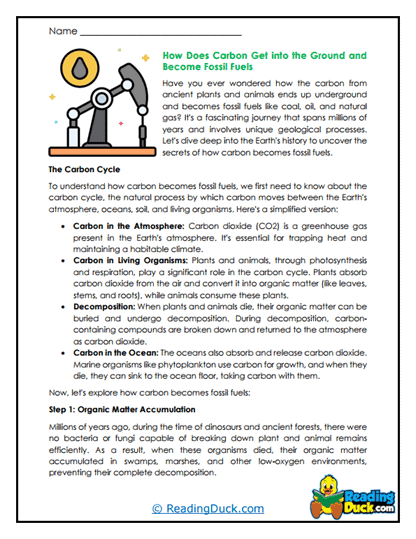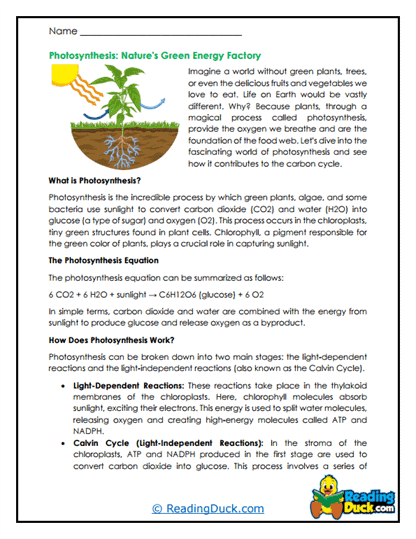Carbon Cycle Worksheets
About Our Carbon Cycle Worksheets
Our collection of Carbon Cycle worksheets offers an in-depth and engaging exploration of one of the most critical processes in biology and environmental science: the carbon cycle. This cycle is essential for understanding how carbon moves through different parts of the Earth, including the atmosphere, oceans, soil, and living organisms. These worksheets are designed to deepen students' knowledge of the carbon cycle, its importance, and its connection to global climate systems.
This collection is a subtopic within Biology and Environmental Sciences and contains several worksheet sets. Each worksheet set includes:
- Multiple Choice Questions: These questions assess students' comprehension of the reading passage, ensuring they grasp the key concepts and details presented.
- Short Answer Questions: This section prompts students to write their responses, encouraging them to articulate their understanding in their own words. This exercise helps reinforce their knowledge and improves their ability to communicate scientific information effectively.
- Open-Ended Questions: These questions invite students to share their personal thoughts, opinions, and reflections on the material, fostering critical thinking and allowing them to connect more deeply with the content.
Each worksheet is accompanied by a detailed answer key, making it easy for educators and parents to review students' work. The worksheets are provided in PDF format, ensuring they can be easily viewed electronically, downloaded, and printed.
Understanding the Carbon Cycle: A Key to Earth's Balance
The carbon cycle is a fundamental component of Earth's system, involving the movement of carbon among the atmosphere, biosphere, geosphere, and hydrosphere. This cycle is crucial for maintaining the balance of carbon dioxide (CO2) in the atmosphere, which in turn regulates Earth's climate and supports life. When introducing students to the topic of the carbon cycle, it’s important to emphasize its complexity, its role in climate change, and its significance in sustaining life on Earth.
The Basics of the Carbon Cycle: The carbon cycle describes the process by which carbon atoms move through the Earth’s various systems:
- Photosynthesis and Respiration: Plants and other photosynthetic organisms play a key role in the carbon cycle by absorbing carbon dioxide (CO2) from the atmosphere and converting it into organic matter through photosynthesis. This carbon is then passed through the food chain as animals consume plants and other organisms. Respiration by plants, animals, and microorganisms returns CO2 to the atmosphere as they break down organic matter for energy.
- Decomposition: When plants and animals die, decomposers such as bacteria and fungi break down their organic matter, releasing carbon back into the soil and atmosphere. This process is a crucial part of the carbon cycle, ensuring that carbon is continually recycled in ecosystems.
- Carbon Sequestration: Some carbon is stored for long periods in what are known as carbon sinks. These include forests, which store carbon in biomass, and the ocean, which absorbs CO2 from the atmosphere. Additionally, carbon can be stored in fossil fuels such as coal, oil, and natural gas, which were formed from ancient organic matter over millions of years.
Human Impact on the Carbon Cycle: Human activities have significantly altered the natural carbon cycle, leading to various environmental consequences:
- Burning Fossil Fuels: The extraction and combustion of fossil fuels for energy release large amounts of CO2 into the atmosphere, disrupting the natural balance of the carbon cycle. This increase in atmospheric CO2 is a major driver of global climate change, leading to rising temperatures, melting ice caps, and more extreme weather events.
- Deforestation: The removal of forests, particularly tropical rainforests, reduces the planet’s capacity to absorb CO2. Trees act as carbon sinks by storing carbon in their biomass. When forests are cut down or burned, this stored carbon is released back into the atmosphere, contributing to the greenhouse effect.
- Land Use Changes: Agriculture, urbanization, and other land use changes also affect the carbon cycle. Practices such as tilling soil for farming can release stored carbon, while the conversion of natural landscapes into urban areas reduces the amount of carbon that can be absorbed by vegetation.
The Ocean’s Role in the Carbon Cycle: The ocean is a major component of the global carbon cycle, acting as both a carbon sink and a source:
- Carbon Absorption: The ocean absorbs a significant portion of the CO2 emitted into the atmosphere. CO2 dissolves in seawater, where it can be used by marine organisms, such as phytoplankton, for photosynthesis. Some of this carbon is transferred to deeper ocean layers, where it can be stored for long periods.
- Ocean Acidification: The increasing absorption of CO2 by the ocean has led to a phenomenon known as ocean acidification. As CO2 dissolves in seawater, it forms carbonic acid, which lowers the pH of the ocean. This acidification can harm marine life, particularly organisms that build shells and skeletons from calcium carbonate, such as corals and some shellfish.
The Carbon Cycle and Climate Change: The carbon cycle is intimately connected to the Earth’s climate, and disruptions to this cycle have significant implications for global temperatures and weather patterns:
- Greenhouse Effect: CO2 is a greenhouse gas, meaning it traps heat in the atmosphere. While this is essential for maintaining temperatures that support life, an excess of CO2 leads to enhanced greenhouse effects, causing global warming. Understanding the carbon cycle is therefore critical for understanding climate change and its impacts on ecosystems and human societies.
- Mitigation Strategies: Addressing climate change requires strategies to reduce CO2 emissions and enhance carbon sequestration. These strategies include transitioning to renewable energy sources, reforestation, and promoting sustainable agricultural practices. Education about the carbon cycle can empower students to understand these solutions and advocate for actions that protect the environment.
By exploring these aspects of the carbon cycle, students will gain a comprehensive understanding of how carbon moves through the Earth’s systems, the impact of human activities, and the critical role of carbon in regulating the planet’s climate. These worksheets will guide students through the fundamental concepts of the carbon cycle, encouraging them to think critically about the connections between natural processes and environmental challenges.
Creative Uses For These Worksheets
Here are four creative ideas on how teachers and parents can use these Carbon Cycle worksheets in school or in a homeschool setup:
- Carbon Cycle Role-Play: Organize a role-playing activity where each student represents a different component of the carbon cycle (e.g., atmosphere, plants, animals, ocean, fossil fuels). Students can use the worksheets to understand their role and then act out how carbon moves between their assigned components, illustrating the cycle in an interactive and memorable way.
- Carbon Footprint Analysis: After learning about the carbon cycle, have students calculate their personal or household carbon footprint. They can use the worksheets to identify areas where they can reduce their carbon emissions, such as by conserving energy, reducing waste, or choosing sustainable transportation options. This activity helps students apply their knowledge of the carbon cycle to real-world decisions.
- Carbon Cycle Art Project: Encourage students to create a visual representation of the carbon cycle using diagrams, drawings, or 3D models. The worksheets can serve as a reference for accurately depicting the flow of carbon through different systems. This creative project allows students to reinforce their understanding while expressing their interpretation of the carbon cycle.
- Debate on Climate Solutions: Use the information from the worksheets to host a classroom debate on the best strategies for mitigating climate change. Students can be divided into groups to research and advocate for different approaches, such as renewable energy, reforestation, or carbon capture technologies. This activity promotes critical thinking and encourages students to consider multiple perspectives on environmental issues.
The Importance of Understanding the Carbon Cycle
Understanding the carbon cycle is essential for students because it is a fundamental process that affects life on Earth and the planet’s climate. Academically, it provides them with a deeper knowledge of biology, chemistry, and environmental science, helping them grasp how interconnected natural systems function. On a personal level, learning about the carbon cycle equips students with the knowledge to make informed choices about their impact on the environment and to engage in meaningful discussions about climate change. By understanding the carbon cycle, students are better prepared to contribute to efforts that protect and sustain our planet for future generations.
